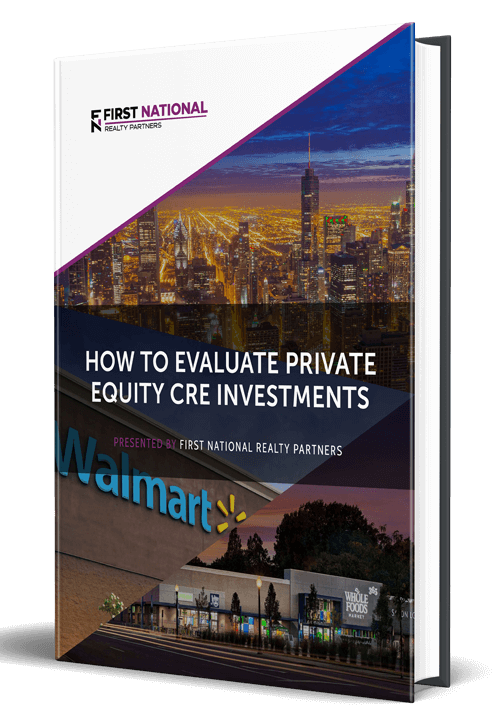One of the tricky parts about measuring the potential profitability in a commercial real estate investment is that there are several ways to do it, and each metric has its own quirks, benefits, and drawbacks. For this reason, investors rarely look at one metric alone, instead choosing to look at a suite of them to get a full picture of returns.
In this article, we are going to discuss one of the most commonly used profitability metrics known as the “Equity Multiple” as it relates to real estate investments. We will describe what it is, how it is calculated, the pros and cons of using it, and what good looks like. By the end, investors will have the information needed to calculate the equity multiple on their own as part of the pre-investment due diligence process.
At First National Realty Partners, we are a private equity firm who specializes in the purchase and management of grocery store anchored retail centers. If you are an accredited investor, interested in partnering with a private equity firm to allocate capital to a commercial real estate investment, click here.
What is the Equity Multiple?
The equity multiple is a commercial real estate performance metric that measures the potential profitability of an investment as a function of the initial amount invested. The result is a number that indicates the “multiple” of the original investment that can potentially be earned.
How Is The Equity Multiple Calculated?
The equity multiple formula is calculated as total money received divided by total money invested:
Equity Multiple = Total Money Received / Total Money Invested
But, arriving at these two numbers can be a bit more complex.
Components of the Equity Multiple Formula
Total Money Received
Total money received is exactly what it sounds like, it is the total amount of money returned by an investment over the planned holding period. To estimate this, investors create a proforma projection of a property’s income and expenses to determine how much is left over at the end of each year to distribute to investors.
When performing analysis on a potential real estate investment, it is important to remember that the total money received is just an estimate only. As such, it is in investor’s best interests to be conservative when estimating it so as to not over artificially boost potential returns. Creating a conservative, and reasonable proforma, is one of the most important aspects of the pre-investment due diligence process.
Total Money Invested
Calculating the total money invested is much easier and there are two ways to do it.
If a property is purchased with cash (which is rare, but it happens), the total money invested is equal to the purchase price of the property.
More commonly, a property is purchased with some combination of debt and equity. In this case, the total money invested is equal to the difference between the loan amount and the purchase price.
Equity Multiple Calculation Example
To illustrate how the equity multiple is calculated, an example is helpful. Suppose an investor is considering purchasing a property for $1,000,000 and they have been approved for a loan of $750,000. As part of their due diligence process, they estimate the property will return $75,000 in cash flow per year for the entirety of a five year planned holding period. In addition, there is a $150,000 gain upon sale at the end of the holding period.
In this example scenario, the total money received is $75,000 * 5 ($375,000) plus the $150,000 gain on sale for a total of $525,000. If the purchase price is $1,000,000 and there is a loan for $750,000, the total equity invested is $250,000.
As such, the equity multiple is $525,000/$250,000 or 2.10x – meaning real estate investors could expect to earn slightly more than double their initial investment.
What is a “Good Equity Multiple?”
The range of what is considered to be a “good” equity multiple can vary widely from one investor to another based on their desired return and risk tolerance. To earn a higher equity multiple, investors must take more risk, which can also result in more variable returns. If an investor wants to take less risk, it also means they will likely have to accept a lower equity multiple.
With this in mind, an equity multiple of at least 2.00x is generally considered to be “good” and the higher the better.
Pros and Cons of Using the Equity Multiple to Measure Performance
Like all commercial real estate return metrics, there are pros and cons to using the equity multiple to measure potential returns.
The major benefit of using the equity multiple is that it is easy to understand and easy to calculate with readily accessible information in a proforma. In addition, it provides investors with a simple way to identify their return as a function of their original investment – which can be very powerful.
However, the major downside to using equity multiple is it does not take into account the amount of time it takes to achieve it. For example, if an investor earns an equity multiple of 2.00x in a three year time period, that is great. But, if they earn that same multiple of 2.00x over a ten year period, the total return probably isn’t as good. For this reason, investors often consider the equity multiple in conjunction with other time based performance metrics like the cash on cash return or internal rate of return (IRR).
What is the Internal Rate of Return?
The internal rate of return is another profitability metric that provides investors with a measure of the return on each dollar invested, for each time period it is invested in.
IRR is rooted in a concept known as the time value of money, which suggests a dollar earned today is worth more than a dollar earned in the future due to its ability to be reinvested and earn interest. The formula used to calculate IRR utilizes the same inputs, initial cash invested and annual cash received, but also includes a time component. For this reason, it can be quite complex to calculate manually and is instead calculated using the “IRR” function in spreadsheet programs like MS Excel or Google Sheets. As a general rule, investors typically target an IRR of 6% – 12% when underwriting their investments.
The pros and cons of using IRR to measure returns are just the opposite of the equity multiple. The major benefit is it does account for the period of time in the investment. However, the downside is it does not provide an indication of the total investment return. In addition, it is easily influenced by when cash flows are earned in the life of an investment.
IRR and Equity Multiple – An Example
To illustrate the differences between IRR and Equity Multiple, consider the following example.
Suppose an investor is trying to decide which of two properties to purchase. As part of their due diligence, they create a proforma financial projection of the total cash distributions, for each property, expected for a five year investment holding period.
In this example, Investment #1 has an IRR of ~19.71% while Investment #2 has an IRR of ~16.37%, which means that investment #1 is better, right? Not necessarily. The IRR in investment number one is skewed higher because the large cash flow occurs early in the holding period, meaning it can be reinvested over a longer period of time, resulting in a higher IRR.
The Equity Multiple for Investment #1 is 1.85X while investment #2 has a higher equity multiple at 1.90X. So, despite the lower IRR, Investment #2 is probably the better project because it has a higher absolute return over the same time period.
The point is this, when evaluating investment opportunities, commercial real estate investors should not look at IRR or Equity Multiple in isolation because they can each be skewed to make an opportunity appear better than it really is. IRR works well when comparing investments with similar time frames but does a poor job of defining an investment’s absolute return and skews higher for investments with large cash flows early in the holding period. Conversely, the Equity Multiple does a great job of measuring the absolute return, but a poor job of accounting for how long it takes to achieve it. Together, these investment metrics can provide a more complete picture of an investment’s total return potential/total profit.
Equity Multiple & Investing Through a Real Estate Syndication
Perhaps one of the hardest parts of evaluating potential real estate deals is trying to filter through which deals hold promise for profit versus which ones do not. The most common way to do this is by creating a proforma projection of income and expenses and using it to calculate a suite of profit metrics to objectively determine which deals have the most potential.
This process is both an art and a science and can take years and hundreds of deal repetitions to master. For this reason, it can be difficult for individual investors to complete on their own, while accounting for things like nuances between asset classes (office buildings, multifamily, etc), how to manage sales proceeds, and how to account for potential changes in interest rates over the term of the planned holding period. As an alternative, individual investors can choose to work with a private equity firm.
Private equity firms are companies that invest in real estate directly or the equity of other companies, including those that own real estate. They typically offer private investments to qualified investors through a deal structure known as a “syndication.” In such a structure, the private equity firm does all of the hard work of finding attractive investment options, analyzing them, arranging the financing, and managing them once the transaction is closed. Individual investors provide capital, but have an otherwise passive role. For those without the time or expertise to manage investment analysis on their own, this can be an attractive option.
Summary of Equity Multiple
The Equity Multiple is a commercial real estate performance metric that provides investors with an investment’s potential return as a function of the original amount invested.
The formula used to calculate the equity multiple is total cash received from the investment divided by the total cash invested. While it can vary widely from one deal to another, a “good” equity multiple is generally above 2.
The benefit of using the equity multiple to measure performance is that it is simple and easy to calculate with readily available information. The downside is it does not consider the amount of time it takes to achieve it.
Because the equity multiple has some shortcomings, it is often measured in conjunction with another return metric known as the internal rate of return. Together, they can provide a fuller picture of an investment’s potential return, helping individuals to make investment decisions.
Interested In Learning More?
First National Realty Partners is one of the country’s leading private equity commercial real estate investment firms. We leverage decades of expertise and our available liquidity to find world-class, multi-tenanted assets below intrinsic value. In doing so, we seek to create superior long-term, risk-adjusted returns for our investors while creating strong economic assets for the communities we invest in.
When evaluating our own investment opportunities, we always use both IRR and Equity Multiple to understand a property’s total profit potential.
If you are an Accredited Investor and would like to learn more about our investment opportunities, contact us at (800) 605-4966 or info@fnrpusa.com for more information.






